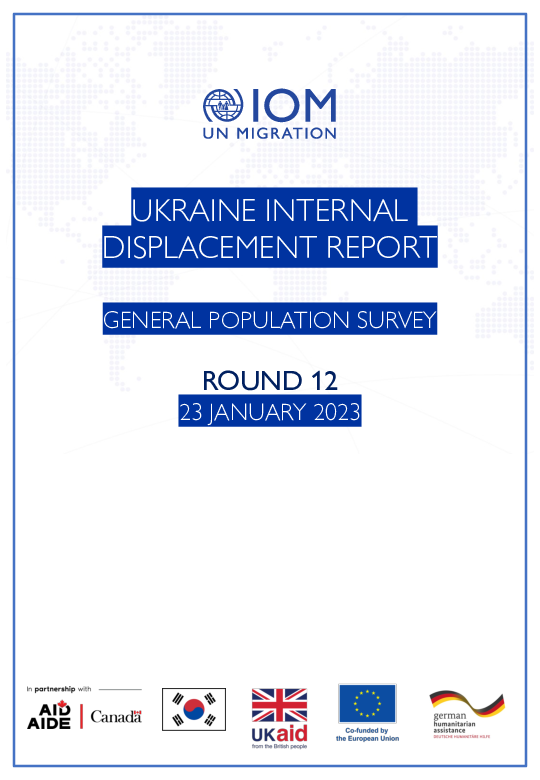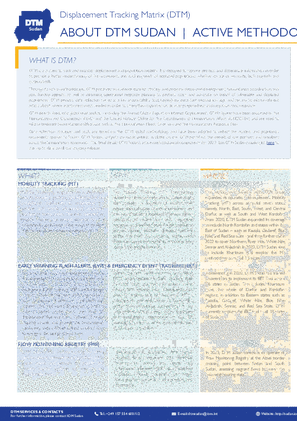-
Countries
-
Data and Analysis
-
Special Focus
-
Crisis Responses

Contact
DTM Peru, IOMDTMPeru@iom.int
Language
Spanish
Location
Peru
Period Covered
Aug 22 2022
Oct 31 2022
Activity
- Flow Monitoring
Ante la necesidad de conocimiento de las características del desplazamiento y movilidad de la población venezolana que transita por la provincia de Tacna, la Organización Internacional para las Migraciones (OIM) ha implementado la Encuesta de caracterización a población venezolana en Tacna desde el 22 de agosto de 2022 hasta el 31 de octubre de 2022, la cual busca recopilar datos sobre sexo, edad, características de viaje, principales necesidades, asuntos de protección, país de destino y contabilizar a los miembros que conforman los grupos de viaje, a las personas encuestadas. También pretende recolectar información sobre el perfil de niñas, niños y adolescentes (NNA) que integran estos grupos de viaje (información que es proporcionada por la persona adulta tutora mayor de 18 años que acompaña a la persona menor).
IOM works with national and local authorities in order to gain a better understanding of population movements throughout Southern Africa. Through the setup of Flow Monitoring Points (FMPs), IOM seeks to quantify migration flows, trends and routes and to gain a better understanding of the profiles of observed individuals at entry, transit or exit points (such as border crossing posts, bus stations, rest areas, police checkpoints and reception centres). This report is an overview of the data collected in these FMPs from 1 to 31 December 2022.
Inter-regional migration from and within the Southern Africa is categorized along the following corridors. The Flow Monitoring Points (FMPs) were set-up in several key transit locations along the corridors to track the movements of passengers:
•Zimbabwe (Mutare) – Mozambique (Manica)
•Zimbabwe – Zambia (Chirundu)
•Zimbabwe – Botswana (Plumtree)
•Zimbabwe (Beitbridge) – South Africa
•Malawi (Mchinji) - Zambia (Mwami)
•Malawi (Karonga ) – United Republic of Tanzania
•Malawi (Mwanza) – Mozambique (Zobue)
•Malawi (Mangochi) – Mozambique
•Mozambique (Ressano Garcia) – South Africa
•Democratic Republic of the Congo (Kasumbalesa) – Zambia
Over the reporting period a total of 87,253 movements were observed across 55 FMPs in the region. The Zimbabwe – South Africa corridor hosted the largest number of movements with 44,490 (51%) followed by the Malawi (Mwanza) – Mozambique (Zobue) corridor with 8,536 (10%) and the Democratic Republic of Congo (Kasumbalesa) – Zambia corridor with 8,373 (10%) movements reported.

Contact
DTMUkraine@iom.int
Language
English
Location
Ukraine
Period Covered
Jan 16 2023
Jan 23 2023
Activity
- Survey
Between 16 and 23 January, the International Organization for Migration (IOM) conducted the twelfth round of a rapid representative assessment of the general population in Ukraine to gather insights into internal displacement and mobility flows, and to assess local needs. This general population survey serves as a high-level source to identify areas with high humanitarian needs and to inform the targeting of response aiming to assist the war-affected population. The geographical scope of the assessment covers the entire territory of Ukraine, all six macro-regions (West, East, North, Center, South, and the city of Kyiv), with the exception of the Crimean peninsula. The general population survey was constructed through a random-digit-dial (RDD) approach, and 2,000 unique and anonymous respondents aged 18 and over were interviewed using the computer-assisted telephone interview (CATI) method. The estimates rely on the UNFPA population data for Ukraine, agreed upon as the common population baseline by the humanitarian community. Those currently outside Ukraine were not interviewed. In addition to this General Population Survey, data on recorded IDP presence at hromada level in Ukraine are available from IOM’s Displacement Tracking Matrix – Baseline Assessment (Round 20, HDX).

Contact
dtmsudan@iom.int
Language
English
Location
Sudan
Snapshot Date
Feb 02 2023
Activity
- Other
DTM is a system to track and monitor displacement and population mobility. It is designed to regularly and systematically capture, process and disseminate information to provide a better understanding of the movements and evolving needs of displaced populations, whether on site or en route. Data collection strategies and tools are based on the DTM global methodology but have been adapted to reflect the context and population movements specific to Sudan.
This product outlines DTM's methodological components operating currently in Sudan namely, Mobility Tracking, Early Warning Flash Alerts and Emergency Event Tracking, Situation Assessments, Registration Activities, Flow Monitoring Registry, Integrated Location Assessment and Multi-Sector Needs Assessment.

Contact
DTM Nigeria, iomnigeriadtm@iom.int
Language
English
Location
Nigeria
Period Covered
Jan 23 2023
Jan 29 2023
Activity
- Mobility Tracking
- Event Tracking
The DTM Emergency Tracking Tool (ETT) is deployed to track and to collect information on large and sudden population movements, provide frequent updates on the scale of displacement and quantify the affected population when needed. As a sub-component of the Mobility Tracking methodology in Nigeria, ETT utilises direct observation and a broad network of key informants to capture best estimates of the affected population per location, enabling targeted humanitarian response planning.
Between 23 and 29 January 2023, a total of 1,831 new arrivals were recorded in locations in Adamawa and Borno states. The new arrivals were recorded at locations in Askira/Uba, Bama, Dikwa, Damboa, Gwoza, Gubio, Monguno, Ngala and Kala Balge* Local Government Areas (LGAs) of the most conflict-affected state of Borno and in Fufore, Gombi, Hong, Lamurde, Michika, Song, Yola South and Yola North LGAs of Adamawa State.

Contact
DTMMozambique@iom.int
Language
English
Location
Mozambique
Period Covered
Jan 25 2023
Jan 31 2023
Activity
- Mobility Tracking
- Event Tracking
During the reporting period (25 to 31 January 2023), a total of 36 movements were recorded - 17 arrivals (1,763 individuals), 15 departures (941 individuals), and 4 returns (37 individuals). The largest arrival movements were recorded in Mueda (630 individuals), Mocimboa Da Praia (532 individuals), Muidumbe (326 individuals) and Macomia (234 individuals). The largest departure movements were recorded in Macomia (453 individuals), and Nangade (343 individuals). The largest return movement was observed within Quissanga (23 individuals). Of the total population, 1 per cent of mobile groups were displaced for the first time, 30 per cent for a second time and 69 per cent were displaced at least three times.
Feb 02 2023
Print
Global experts from DTM and Clear Global/Translators Without Borders jointly identified common Information needs for language data, that DTM methodologies can provide, and recorded a webinar to help DTM and other colleagues in the field identify and collect the information they need to communicate with affected people. Country-specific information on languages and recommended questions for various methods of data collection are available on the Clear Global site.
Feb 02 2023
Print
DTM for Prevention of Sexual Exploitation and Abuse
DTM and Global Partners, jointly identified common Information needs for PSEA data, that DTM methodologies can provide, and developed short guidance for DTM and PSEA colleagues in the field.
Since 2014, the Lac Chad Basin region has been affected by multiple incidents and threats, causing the displacement of millions of persons in
the region including internal displaced people and refugees. Affected populations have moved away from their usual place of residence, to settle in areas that are more or less secure, fearing for their lives and those of their families. This situation led to the deterioration of social cohesion and to the installation of mistrust among the different population groups. Besides the insecurity, the region is also affected by the phenomena of disasters (drought, floods etc) triggered by climate change, destroying the houses and agricultural farms of vulnerable populations already living in a difficult situation. The most affected populations are children, women, and elder persons with different vulnerabilities. The security situation and the disaster events have a negative impact on the livelihoods and
the economy of the region, reducing the opportunities for host communities and displaced populations to have a better life.

Contact
rodakar-dataresearch@iom.int
Language
English
Location
The Gambia
Period Covered
Oct 01 2022
Dec 31 2022
Activity
- Flow Monitoring Survey
- Flow Monitoring
In order to gain a better understanding of mobility flows and trends throughout West and Central Africa, the International Organization for Migration (IOM) implements the Displacement Tracking Matrix’s Flow Monitoring (FM) tool at key transit points across the region.
Flow Monitoring activities are conducted in close cooperation with national and local authorities as well as with local partners. The Flow Monitoring tool consists of two main components: the Flow Monitoring Registry (FMR), which captures key data on the magnitude, origin, destination and mode of travel of mobility flows, and the Flow Monitoring Survey (FMS), for which individual surveys are conducted with travellers to gather detailed information about the profiles, migration experience and intentions of migrants. Through these activities, the Flow Monitoring tool collects data on migration flows and trends, traveller profiles, migration journeys and intentions of migrants in order to obtain a deeper view of mobility in West and Central Africa.
In The Gambia, DTM conducts Flow Monitoring activities at several important transit locations: in 1) Barra (FMPs are located at the ferry terminal and the main garage);
2) Farafenni (FMPs are located at Farafenni main garage, Farafenni Ballan-Ghar garage, Farafenni McCarthy and Sanjally garage, Farafenni turntable garage and the truck garage); 3) Basse (FMPs are situated at the main garage and the bus station in Basse Santa-Su) and 4) Brikama (FMPs are located at the main garage and the Bus station).
This activities enable DTM to monitor the movements of passenger within The Gambia, out of and towards The Gambia as well as transiting The Gambia.
This report presents the key results from the Flow Monitoring Survey conducted with travellers between 1st October to 16th December 2022. The report presents data collected on flows, routes, provenance, destination and demographic profiles of travellers observed at the FMPs.
Additional information on Flow Monitoring methodology is available on the last page.

